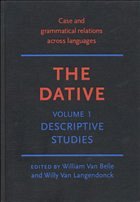Main description:
Since antiquity, scholars have been fascinated by the phenomena of case. The explanation for this fascination is, as Hjelmslev already pointed out over fifty years ago, the fact that he who can unravel the meaning of case-relations, has the key to language structure as a whole.
For over three years, a team of twenty scholars affiliated with the Linguistics Department of Leuven University in Belgium has concentrated on case phenomena in different languages, both Indo- and non-Indo-European. It is the first time that such a large scale investigation into case has been undertaken. Noteworthy is also its reliance on computer-stored corpora of authentic material.
The results are published as a series (Case and Grammatical Relations across Languages) of which the first volume, a bibliography, appeared in 1994.
The first volume on the dative case contains 13 articles, each of which gives a detailed syntactic-semantic description of the dative or its counterparts in a particular language. In addition to the lexico-syntactic frames in which they occur, a number of textual and extra-linguistic factors are taken into account. Languages investigated are English (K. Davidse), German (L. Draye), Dutch (W. Van Belle W. Van Langendonck), Afrikaans (L.G. de Stadler), Latin (W. Van Hoecke), French (L. Melis), Spanish (N. Delbecque B. Lamiroy), Portuguese (R. de Andrade), Polish (B. Rudzka-Ostyn), Hungarian (G. Tóth), Pashto (W. Skalmowski), Hebrew (P. Swiggers) and Orizaba Nahuatl (D. Tuggy).
Table of contents:
- List of abbreviations
- Introduction
- Part I: Romance languages
- 1.The Latin dative
- 2.The dative in Modern French
- 3.Towards a typology of the Spanish dative
- 4.The Portuguese dative
- Part II: Germanic languages
- 1.The German dative
- 2.The indirect oject in Dutch
- 3.The indirect object in Afrikaans
- 4.Functional dimensions of the dative in English
- Part III: Unrelated languages
- 1.The Polish dative
- 2.Dative counterparts in Pashto
- 3.Dative-like constructions in Orizaba Nahuatl
- Subject Index
Since antiquity, scholars have been fascinated by the phenomena of case. The explanation for this fascination is, as Hjelmslev already pointed out over fifty years ago, the fact that he who can unravel the meaning of case-relations, has the key to language structure as a whole.
For over three years, a team of twenty scholars affiliated with the Linguistics Department of Leuven University in Belgium has concentrated on case phenomena in different languages, both Indo- and non-Indo-European. It is the first time that such a large scale investigation into case has been undertaken. Noteworthy is also its reliance on computer-stored corpora of authentic material.
The results are published as a series (Case and Grammatical Relations across Languages) of which the first volume, a bibliography, appeared in 1994.
The first volume on the dative case contains 13 articles, each of which gives a detailed syntactic-semantic description of the dative or its counterparts in a particular language. In addition to the lexico-syntactic frames in which they occur, a number of textual and extra-linguistic factors are taken into account. Languages investigated are English (K. Davidse), German (L. Draye), Dutch (W. Van Belle W. Van Langendonck), Afrikaans (L.G. de Stadler), Latin (W. Van Hoecke), French (L. Melis), Spanish (N. Delbecque B. Lamiroy), Portuguese (R. de Andrade), Polish (B. Rudzka-Ostyn), Hungarian (G. Tóth), Pashto (W. Skalmowski), Hebrew (P. Swiggers) and Orizaba Nahuatl (D. Tuggy).
Table of contents:
- List of abbreviations
- Introduction
- Part I: Romance languages
- 1.The Latin dative
- 2.The dative in Modern French
- 3.Towards a typology of the Spanish dative
- 4.The Portuguese dative
- Part II: Germanic languages
- 1.The German dative
- 2.The indirect oject in Dutch
- 3.The indirect object in Afrikaans
- 4.Functional dimensions of the dative in English
- Part III: Unrelated languages
- 1.The Polish dative
- 2.Dative counterparts in Pashto
- 3.Dative-like constructions in Orizaba Nahuatl
- Subject Index
